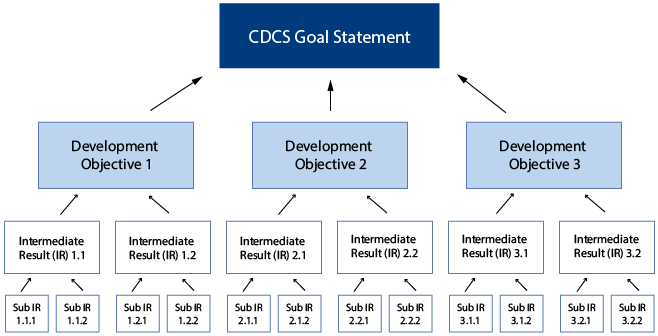Speeches Shim
| FEATURED |
|---|
USAID Technical Note on Developing Results FrameworksThis Note provides new and experienced USAID staff with a clear explanation of how USAID constructs Results Frameworks and the relationship between these program logic models and project design. Results Framework Indicator Annex |
A Results Framework (RF) graphically displays the results USAID intends to achieve over a CDCS period. The "Theory of Change" that underlies USAID’s strategy is revealed through arrows in the diagram that identify causal linkages through which Sub-IRs and IRs (at the bottom) help to bring about DOs and progress towards the CDCS Goal at the top.
A Results Framework is a graphic portrayal of the development hypotheses through which a Mission expects to achieve the Goal of a CDCS. Visually, a Results Framework brings together several, often quite distinct, streams of results, which function synergistically to produce broad development changes. Thus, an economic growth result in a Results Framework might join with a health and an education results to realize CDCS Goal stated in citizen welfare terms.
In Results Frameworks, results levels have distinct labels which are associated with the degree of responsibility USAID is accepting for their achievement as well as with their relationship to other results on the diagram.
ADS 201 requires that preliminary performance or context indicator(s) must be included in the Results Framework Indicator Annex rather than in the Development Hypothesis or Results Framework sections of the CDCS. This Results Framework Indicator Annex template has been developed to provide a structured approach to organizing such an annex. Missions should adjust the tables as necessary to reflect the number of DOs, IRs, and Sub-IRs outlined in their CDCS.
- CDCS Goal Statement: the highest level outcome to be advanced or achieved by USAID, the host country, civil society actors and other development partners within the CDCS timeframe. USAID is expected to show progress toward the CDCS Goal, but the burden of getting there is a shared responsibility. In some countries USAID’s CDCS Goal may be linked to objectives in the country’s national plan or realization of the Sustainable Development Goals. Care should nonetheless be taken to ensure that even a multi-dimensional CDCS Goal is clear and measurable.
- Development Objective (DO): the most ambitious result that a Mission, together with its development partners, can materially affect, and for which USAID will be held accountable to demonstrate impact. USAID limits the number of DOs included in a CDCS to four, as shown in the example below.
- Intermediate Results (IRs) are the set of results that support, and are necessary for, the achievement of a DO. IRs, in turn, are achieved when sets of sub-IRs , which may also be displayed on a Results Framework, are attained.

For Trade Aspects of a Results Framework Consider the Following Resources
- Trade Results in Current CDCS Results Frameworks: Learn what others have done
- An Illustrative Hierarchy of Trade Results: This was created based on result linkages found across 256 USAID trade projects
- Two Results Framework Templates are included for your use:
Also See
USAID's updated description of the elements of a Results Framework can be found in the CDCS Guidance and in USAID's Automated Directives System (ADS) 201.3.3.3
| << Development Hypotheses | Up | Trade in CDCS Strategies >> |
ProjectStarterBETTER PROJECTS THROUGH IMPROVED |
A toolkit developed and implemented by: For more information, please contact Paul Fekete. |

Comment
Make a general inquiry or suggest an improvement.